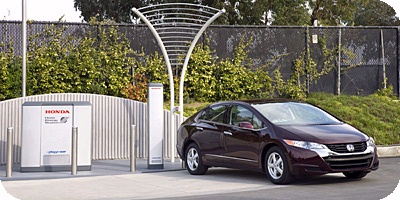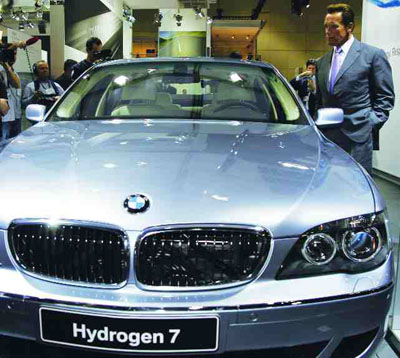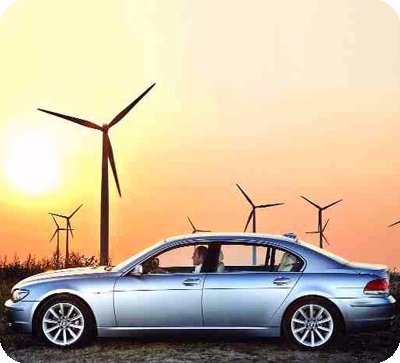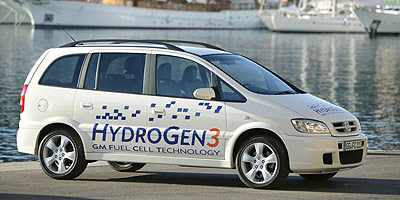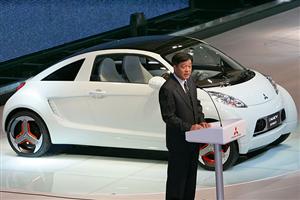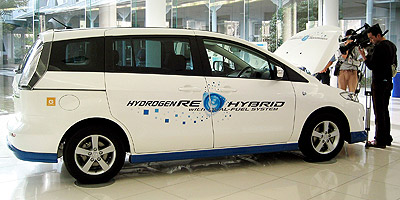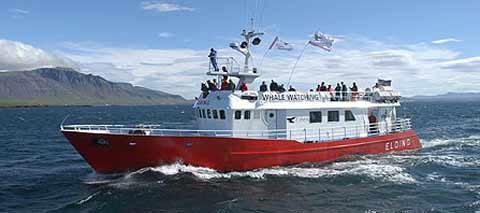|
|
|||||||||||||||||||||||||||||||
|
Hydrogen POWER
Hydrogen Power becoming a RealityReal-world vehicles fuelled by hydrogen are finally arriving from Honda and BMW. But some experts insist they'll create more problems than they cure Blues skies. Green trees. Birds chirping. That's the hydrogen fuel-cell car marketer's dream. But what's the reality? For more than a decade, automakers have pushed the praises of hydrogen as the next big thing. Car maker efforts have ranged from dabbling in hydrogen, Mazda with its 2004 RX-8 Hydrogen Rotary Engine concept, to Toyota parading its hydrogen-powered Highlander along the Alaska Highway, to more extensive test fleets: 100 Chevrolet Equinox fuel-cell vehicles are scheduled to be delivered in the new year to families across the U.S. for a three-month review. Beyond the test market, hydrogen-powered cars, vehicles that once appeared to be nothing more than an exercise in research and development, are finally arriving to the public. But the do-good cars, emitting only water and not emissions, could be riddled with more limits than advantages. The headline-grabbing story at last month's Los Angeles auto show was the announcement of the Honda FCX Clarity, the world's first production fuel-cell car. Starting next summer, a limited number of Californians will be able to lease a hydrogen car for 36 months as their daily driver. The cost? A respectable $600 per month. The news one-upped BMW, which, until the announcement of the FCX, was leading the way in hydrogen development. BMW's Hydrogen 7, based on the long-wheelbase 7 Series with a V12 internal combustion engine, can be powered by gasoline as well as liquid hydrogen. When it's running on hydrogen only, the result is no carbon dioxide emissions. The major difference between the Honda and BMW? The 7 Series isn't for sale – yet. Wilhelm Hall, BMW North America's general manager of environmental engineering, says the Hydrogen 7 is "production-ready," but that only 100 celebrities and politicians have received a loaner car for evaluation and to provide feedback. Though Hall won't suggest when the car would make it to the public, he does hint at the cost of early hydrogen cars. "I could see us selling it for around $250,000 in low numbers," Hall estimates. "But once we get to producing tens of thousands, the price goes down dramatically." Hall says that unlike Honda's technology – the FCX's hydrogen is stored on board and processed into electricity via a fuel-cell stack that powers an electric engine – having a combustion engine in the Hydrogen 7 makes it seem closer to reality than a full-blown hydrogen car. "Fuel cells are simply not cost-effective," Hall says. Despite the diverging technical paths, both BMW and Honda are professing the same utopian result: clean, clear water evaporating out of their hydrogen car tailpipes. Dennis DesRosiers, a Canadian automotive industry analyst and president of DesRosiers Automotive Consultants, had firsthand experience with Honda's FCX Clarity at a test facility in Japan. He thinks the hydrogen car's potential is reminiscent of the company's breakthrough CVCC engine in the 1970s. The technology helped Honda meet U.S. emission standards and improved fuel economy – without a catalytic converter. But there's one catch: if Honda expands the availability of the FCX beyond California and BMW makes its Hydrogen 7 available to non-red-carpet types, DesRosiers says the biggest issue won't be product demand, but where to fuel a hydrogen car. The infrastructure, it seems, isn't up to speed with the progress of the technology. According to H2stations.org, a website that tracks hydrogen refilling stations, there are only 10 certified filling stations in Canada (and those are used for industrial purposes), 38 in Europe and 49 in the U.S. (with more than half in California). "The fact is, it's still hard to find diesel at the pumps," DesRosiers says. Along with the L.A. auto show announcement of the production FCX, Honda tried to address the infrastructure problem with its experimental Home Energy Station, a self-contained unit that converts natural gas into hydrogen to fuel the FCX, and to supply electricity and hot water to a home. But some experts don't think that's a good idea. "Burning natural gas to create hydrogen has to be the dumbest way to deal with greenhouse gas effects," says Joseph Romm, author of The Hype about Hydrogen. Romm is a former official at the U.S. Department of Energy's Office of Energy Efficiency, and currently a senior fellow at the Center for American Progress, where he oversees the blog ClimateProgress.org. He says that despite the billions spent annually on climate change, automakers just don't "get" global warming. Energy reformers, such as Honda's experimental home system, only make sense on a large scale, Romm says. The true cost of hydrogen fuel from any home-filling station will be exponentially higher than gas at the pumps. Honda also admits that the $600 monthly lease rate for the FCX doesn't cover the cost of building the car. When the bill for hydrogen-car research and development, and the price to power fuel-cell cars outweighs the financial gains, why do automakers continue to invest in the alternative energy? "Car companies don't want to look like they're against better solutions," Romm says. Based on his experience, the solution to greenhouse gas emissions won't be solved by throwing money at new technologies. "As a whole, I wouldn't stake my mortgage on hydrogen cars. The infrastructure solution is the wild card," Romm says. The issue of filling stations is also part of the problem for BMW with its Hydrogen 7. "We have the (vehicle) production figured out. We are more ready than the energy providers," says Hall. "It's difficult in the U.S. In the long term, there's no vision or plan. Whereas in Europe, there's more public and political will for both a liquid and gas hydrogen infrastructure." In a culture desperately looking for environmentally friendly transportation solutions, it's hard not to get excited about hydrogen-powered cars and their promise of clean, green transportation. But the automotive utopia is hard to pin down, DesRosiers says. "Right now, I can count over 10 variations of propulsion being worked on – from efficient internal combustion engines to fuel cell." Regardless of the technology, Romm argues the only immediate answer is to legislate higher fuel economy regulations. "That means low-emission petroleum cars, either gasoline or diesel, are the only feasible short-term solution." And as an alternative energy source "it has to be electricity," he says.
State laws pushing zero-emission cars now allow fuel cellsThe U.S. Environmental Protection Agency has cleared the way for auto makers to produce hydrogen-powered fuel-cell cars, to help meet zero-emission vehicle requirements in California and 10 other states. The EPA approved amendments adopted by the California Air Resources Board in 2003 that allow manufacturers to produce fuel cells as an alternative to the battery-powered cars and light trucks previously required by the state. Since then, 10 other states – Connecticut, Maine, Massachusetts, New York, New Jersey, Oregon, Pennsylvania, Rhode Island, Vermont and Washington – have adopted the same rules. "This waiver simply reflects the prominence of fuel cells," says John Millett, an EPA spokesman. California initially adopted its regulations in 1990, requiring by 2003 that 10 per cent of all new cars sold in the state by major manufacturers be zero-emission vehicles. The rules have been modified several times since then. Currently, they call for 2 per cent of the six biggest auto makers' new cars to be zero-emission, 2 per cent to be gasoline-electric hybrids and 6 per cent to be super-low-polluting gasoline-powered vehicles, known as PZEVs (partial zero-emission vehicles). The hybrid and PZEV requirements, which some smaller companies must also meet, took effect in 2005. The 2 per cent requirement for fuel-cell- or battery-powered cars starts in 2009, with a ramp-up period that will require the industry to market at least 2,500 of the vehicles nationwide over the first three years of the program and larger numbers in subsequent years, says Jerry Martin, an CARB spokesman. The programs allow manufacturers to produce either battery-powered or fuel-cell vehicles, which use hydrogen and oxygen to run an electric motor. But Martins doubts companies will opt for battery power. "Battery technology has been moving forward and batteries are still zero-emission technology, but the car companies have made it very clear that fuel cells are the technology of the future," he says. General Motors Corp. spokesman Dave Barthmuss says fuel-cell vehicles are "very viable to be a portion of any auto maker's compliance strategy." "A lot of milestones are being met and a lot of progress is really being made" in developing the vehicles, he adds. GM plans to put 100 fuel-cell vehicles on the road next year as a demonstration project. But Barthmuss says the CARB should stay in line with the "pace of technology." Jennifer Moore, a spokeswoman for Ford Motor Co., says there is still a lot of uncertainty about fuel-cell vehicles. Ford, she added, agrees with a federal forecast that predicts the vehicles won't be available in large numbers before 2015. "There are a lot of challenges that remain ahead for fuel-cell vehicles, everything from infrastructure to cost to range," she says. "In terms of when they're going to be commercially viable, it's pretty difficult to say at this point."
Is hydrogen power the future?Dramatic changes in driving forecast by hydrogen and fuel cell experts "The consequences of doing nothing will be dramatic." - Bill Reinert. In this year of heightened concern, if not hysteria, over global warming, and the political battles being waged over what the appropriate courses of action should be, that sort of comment could have been made by any number of those who believe the end is nigh. But when it comes from an advanced technology engineer with a major auto manufacturer, perhaps we ought to listen carefully. Those words were spoken by Bill Reinert, National Manager of the Advanced Technologies Group at Toyota, at the Hydrogen and Fuel Cells 2007 International Conference in Vancouver last week. He was joined there by Dr. Christine Sloane, Global Leader and Director of Hydro gen Fuel Cell Codes and Standards with General Motors, and if you get past the grand titles, these two eminent authorities are in charge of no less than planning the technological future of their respective auto companies in a challenging and rapidly changing world. As such, they are visionaries whose opinions carry a lot of weight. The two took slightly different approaches to the discussion, with the common thread that hydrogen as the energy source for personal transportation is the solution. Reinert took a fairly broad view, including political and environmental ramifications that go beyond just making air cleaner. Related story: Fuel cells' rocky road "Our energy future is now in the hands of the OPEC countries. The oil supply from them and from the former Soviet Union countries is expected to peak at a bit over 90 million barrels per day within the next 10 years or so. "But predictions are that the world will require about 125 million barrels per day by 2020. There is no scenario we can envision, no combination of petroleum or renewable resources, that will allow the consumption of that level of energy per day." The predictions get worse. "We are looking at a world population of 3-to-4 billion people. At the moment we have 250 million cars on the road in the U.S. and 750 million worldwide, and if we look at population growth and the increasing penetration of the automobile in developing markets, we see a situation where there may be 2 or even 3 billion cars on the road by 2040, and an environmental impact far beyond what we are looking at today. "There are three things we are going to have to do to realize a hydrogen-based economy," Reinert concluded. "We have to continue research and deal with the technical challenges. We have to prepare society so that people understand what the issues are. And we have to rethink the urban environment and embrace mass transit." Sloane echoed his comments. "There has never been a time more right for a change in transportation than now. Conservative estimates put the need for energy rising 70 per cent in 30 years if only from the growth in developing countries. "We can't continue doing what we are doing now, can't just do it a little better or be more efficient. We are going to have to change. And 30 years in the automotive industry is not that far out. "We have to find sustainable energy solutions. We need to have energy that is assured; we can't continue to have geopolitical factors causing energy to be at risk." She went on to say that there is one overriding concern. "Long term, we've got to get off petroleum. And we don't need to shift to something else that will cause the same problems. We need to shift to a new form of energy that is diverse and allows renewable energy sources to grow seamlessly with existing technology. "Hydrogen is perfect. Among its attributes is that you can make it from a number of different sources, and it generates no emissions in vehicles. "So our strategy is clear. We are looking to move the vehicle away from a mechanical analogue system to a digitized electric one." Of course, the car-buying public has the final say. "How do we ensure public acceptance of this new technology?" Sloane asks. "If we establish standards that relate to the conditions of today, we will always do things like we do today. We have to state the performance that we want, so that the technology can be developed around the performance that is required, be it efficiency or safety or whatever. "And we need to motivate society to accept the transfer to the new technology, via accelerating the diversity of energy sources and the development of infrastructure. That is our task, and when it all gets done, we'll be moving forward." Reinert leaves no doubt that the public is already clamouring for change. "The pressure to develop the solution is growing," he says. "We can acutely feel the public pressure for change. It's not like it's early adopters who are talking about this, it's everybody. We don't get much sleep." He said it with a chuckle, but the message is clear. There is no turning back now on the road to hydrogen-fueled personal mobility.
Cost, infrastructure hinder hydrogenEthanol may be the flavour of the moment, in terms of alternative fuels, but hydrogen is the long-term darling of auto makers and politicians alike. To quote General Motors' R&D head Larry Burns, one of the industry's biggest hydrogen boosters, hydrogen provides the potential to "remove the automobile from the environmental equation." A vehicle using hydrogen (H2) as its fuel would be virtually emissions-free, its only significant byproduct being water. In addition, hydrogen can be produced, with varying degrees of efficiency, from multiple sources, almost anywhere. Consequently, the security-of-supply issue that plagues the world's fossil-fuel resources could be all but overcome by the adoption of a hydrogen economy. There are, however, still many other problems to overcome before hydrogen has a realistic possibility of becoming our fuel of choice – problems on both the vehicle and fuel sides of the equation. The challenges facing the commercialization of hydrogen fuel cells are well known – cost still being among the most vexing. But fuel cells are not the only powerplants capable of running on hydrogen. BMW, Ford and Mazda have all developed conventional internal combustion (IC) engines that operate on H2 and all three are in the process of putting hydrogen-powered vehicles into real-world service in demonstration fleets around the world. In addition, both Honda and General Motors are in the process of building 100-vehicle-strong fleets of fuel cell demonstration vehicles for real-world evaluation; DaimlerChrysler already has more than that number in service; Ford, Nissan, Toyota and most other auto makers have smaller numbers of FCEVs (fuel-cell electric vehicles) in various test fleets. I may be a hopeless optimist, but based on the progress that has occurred over the past decade, I am confident that at least some hydrogen-powered vehicles, fuel-cell or IC-engine powered, will be in series production and available to the public by 2015, if not before. If, that is, there is a hydrogen infrastructure in place to support them. It is a very big "if." Hydrogen is the most plentiful potential fuel on Earth, but it doesn't exist in pure form in nature. It is always compounded with one or more other elements, such as oxygen in water (H2O) or carbon in a vast array of hydrocarbon fuels, such as gasoline, or natural gas, or ethanol or coal. To be used as a fuel itself, it has to be extracted from one of those compounds. Not only does that mean some other source must be depleted, it means energy must be expended in the process. Hydrogen can be "reformed" from such fuels as gasoline or methanol, but the most common base-stock for its production is natural gas, itself a depleting resource, and the energy losses in such conversion are significant. It can also be "electrolyzed" from water, but that process requires substantial amounts of electrical energy, which could further increase the demand for natural gas, or prompt the construction of more nuclear generating stations, which is a controversial solution at best. The ideal answer – the only answer in the minds of some environmental stewards, including many hydrogen proponents – would be electrolysis of water using electricity generated by some benign, renewable means, such as solar, geo-thermal, tidal or wind power. Until that happens, the production of hydrogen incurs ancillary costs that must be weighed against any reduction in petroleum use that may result. Furthermore, while vehicles running on hydrogen may produce few or no tailpipe emissions, the production of hydrogen may itself be polluting, depending on the process used. Beyond those issues, there is the matter of its cost, as well as the challenges of transportation and storage. Even when contained at very high pressures (10,000 p.s.i.) or very low temperatures (-253C), a tank the size of a conventional gasoline tank would provide a range significantly less than that of today's equivalent gasoline-powered car. That is one reason why BMW's Hydrogen 7 – 100 models of which will begin production this year – uses cryogenic liquid hydrogen (LH2), rather than compressed gaseous hydrogen, which most other automakers favour. Liquefying the fuel, BMW says, makes it easier to handle and transport using conventional methods, as well as increasing its energy density to a level that will provide an acceptable operating range from a reasonably sized fuel tank. There is one other elephant in the room that may significantly affect hydrogen's acceptance as a vehicle fuel. It is called the Hindenburg. It is almost 70 years since the conflagration that consumed the mammoth airship while it was landing at Lakehurst, N,J., but the legacy of that disaster lingers on in an almost universal fear of the hydrogen gas that fuelled those dramatic flames. In fact, hydrogen's proponents say, it is actually less dangerous than many other fuels, including gasoline. Being lighter than air at ambient temperature, if a leak occurs it quickly dissipates into the atmosphere rather than pooling in a concentrated mass that can be easily ignited. Depending on how it is produced, hydrogen has much to offer as a vehicle fuel. But it also has many challenges to overcome if its promise is to be realized. "It is the fuel of the future," one wag declared, "and it always will be."
China auto makers roll out 'clean' carsSHANGHAI, China — One experimental clean-energy car runs on natural gas. Another uses ethanol distilled from corn. A third has a zero-emissions electric motor powered by a hydrogen fuel cell. These alternative vehicles were created not by a global automaker but by China’s small but ambitious car companies, which displayed them Sunday alongside gasoline-powered sedans and sport utility vehicles at the start of the Shanghai Auto Show. At a time when they are still trying to establish themselves in international markets, Chinese automakers are already investing in such avant-garde research in a bid to win a foothold in the next generation of technology. “This is the tide of the industry. If you don’t go with the tide, the industry will pass you by,” said Qin Lihong, a vice president of China’s biggest domestic automaker, Chery Auto Co., in an interview ahead of the show’s opening. China’s communist leaders are encouraging the development as part of efforts to cut pollution and rising dependence on imported oil and to make this country a creator of profitable technologies. Chinese manufacturers are getting help from foreign automakers in joint ventures and from research alliances with Chinese universities and government laboratories. Beijing has made cleaner cars a policy priority, targeting the field as one of 11 priority areas in a 15-year technology development plan issued in February 2006. It promised grants and tax breaks to support industry efforts. The campaign embodies one of Beijing’s strategies in technology development: Pick new areas with no entrenched competitors so China can make breakthroughs without huge costs. While foreign automakers have a lead in conventional technology, ``in new energy we’re starting from almost the same line,” said Chen Hong, the president of Shanghai Automotive Industries Corp. “So we believe we can catch up with other auto companies and make great progress in developing new energy vehicles,” Chen said. China’s leaders are pressing its auto, steel, manufacturing and other industries to improve energy efficiency and cut pollution. They see China’s rising reliance on imported oil as a strategic weakness, especially since much of it comes from the politically volatile Middle East and crosses seas beyond Beijing’s control. China already is the world’s No. 2 oil consumer after the United States and saw imports soar by 14.5 percent in 2006, driven by economic growth that has topped 10 percent for the past four years. A boom in car sales has added to smog shrouding China’s major cities, which are among the world’s dirtiest. Vehicle sales jumped 25.1 percent last year to 7.2 million units, including 3.8 million passenger cars. At the Shanghai show, both SAIC and Chery displayed experimental fuel-cell sedans, while they and a third Chinese automaker, Chang’an Automobile Group Co., also showed gasoline-electric hybrids. SAIC said it will start selling its hybrid next year, while Qin said Chery’s would go on the market in two to three years. “The hybrid will be our focus,” SAIC chairman Hu Maoyan said at a news conference. “The fuel cell will be our direction.’’ SAIC has spent 100 million yuan ($12 million) on fuel cell research, according to state media. Chery had the widest array of alternative vehicles on display at the Shanghai show. They included models outfitted to run on bio-diesel made from vegetable oil or a “flexible fuel” choice of compressed natural gas or ethanol. Foreign automakers also are playing a role in China’s research. General Motors Corp. has a joint-venture technology center with SAIC in Shanghai and operates three experimental fuel cell buses in the city. DaimlerChrysler AG has three of its own fuel cell buses running regular routes in Beijing in a research project with the technology ministry. Foreign automakers including GM, Ford Motor Co., BMW AG and Honda Motor Co. displayed their own hybrids and experimental fuel cell cars at the Shanghai show. Company officials said hydrogen fuel cells, which produce power with no exhaust, are the cleanest option. But they say it could be a decade or more before such technology is commercially feasible, due partly to the need to create a network of hydrogen filling stations. Chinese authorities also are looking at other possible fuels such as natural gas and methane extracted from coal, said Mei-Wei Cheng, the president of Ford’s China operations. “This is not an easy decision, because every option has pros and cons,” Cheng said. “The government is trying to find a solution as quickly as possible, but this is a difficult problem.’’
Fuel-cell work on track despite Ballard sell-offEnd of the fuel-cell dream? Not really. A hydrogen-powered shock wave echoed through the fuel-cell industry earlier this month, when Ballard Power Systems of Vancouver, arguably the pioneer in the field of automotive fuel cells, announced that it is getting out of the business. It was a revelation with the same kind of import as that of Kodak getting out of the film business. A flag of surrender, acknowledging that there is no future for fuel cells in automobiles. Or was it? While some observers and analysts interpreted it that way, the reality is not quite that stark. Ballard's move did reflect a recognition that the potential for making money from the mass production of fuel cells is still several years away. And like any company, Ballard needs to make money. The possibility of doing so with fuel cells is greater, sooner in the lift-truck, emergency power and cogeneration markets than in autos, where considerable investment in research and development must still be made before large-scale commercialization. What the company did, therefore, was spin off the automotive portion of its business, including intellectual property, hard assets and personnel to a new company called Automotive Fuel Cell Co-operation Ballard retains a 19.9 per cent interest in AFCC. Daimler AG holds a 50.1 per cent interest, while Ford holds 30 per cent. Daimler and Ford effectively cashed in their shares in Ballard to create the new company. So the work goes on. But it's now to be done within a privately held company that is not under the same pressure to generate short-term revenue as Ballard is as a public company. From the automakers' perspective, it is business as usual as they continue to work toward commercialization of the technology. The AFCC will serve as a "think tank ... going full steam ahead in our preparations for the large-scale production of fuel-cell cars," said Herbert Kohler, Daimler's vice-president and chief environmental officer. A fuel cell is similar to a battery except that, rather than simply storing electrical energy, it generates it through a chemical reaction of hydrogen and oxygen. The products of that reaction are electricity and water. Rapid advances in fuel-cell development over the past decade have resulted in size reductions such that an automotive fuel cell can now be fitted in a space similar to that required for a conventional internal combustion engine. John Viera, Ford's director of sustainable business strategies, confirmed Ford's ongoing commitment to bring fuel-cell-powered vehicles to production. He was in Toronto for a conference on climate change when the AFCC deal was announced. "Hydrogen-powered fuel cells offer the prospect of freedom from oil and zero emissions, including carbon dioxide emissions, and Ford is by no means giving up on that promise," he told me. But Viera acknowledged that the prospects for widespread commercial application of fuel cells in vehicles is more long-term than medium-term. It could be as far away as 2020 or beyond. Ford is pushing hard on the technology, he said, and has several demonstration vehicles on the road, including five Focus FCVs now in service in Vancouver. But, Viera added, huge challenges must still be overcome, specifically in the areas of hydrogen storage and infrastructure. The storage challenge is how to contain enough hydrogen to provide the driving range customers want in a tank small enough to fit in a car without compromising passenger and cargo space. It's a matter of physics. Currently, even with hydrogen gas compressed to a pressure of 700 bars (10,000 p.s.i.), a tank big enough to provide a range of 400-to-500 km is much larger than a conventional gas tank that would provide the same driving range. The infrastructure challenge is how to produce and distribute hydrogen. We may see unprecedented collaborations between automakers and energy companies, Viera suggested.
Iceland's hydrogen ship heralds fossil-free futureREYKJAVIK–At first glance, the red ship hardly looks like a herald of the future. Even its owner admits the hull needs a coat of paint and the interior some spit and polish. But in a few weeks, the Elding – Icelandic for "Lightning" – will be transformed into the world's first hydrogen-equipped commercial vessel, the latest sign that Iceland is pushing hard to become the first nation to break free from the constraints of fossil fuel. Come April, visitors to Europe's northernmost capital will get a taste of that future by taking whale-watching tours aboard the ship, or renting one of the world's first hydrogen-powered hire cars. The conversion of the Elding to hydrogen power will initially be confined to the use of a fuel cell to power the engine that runs its lighting, but for 43 euros ($62.26) a trip, the ship will offer whale-watchers unprecedented peace. When the crew spot whales at sea, they shut down the main engines to let people hear the mammals swim and blow water – an experience owner Vignir Sigursveinsson said had been marred in the past by the rumble of a diesel auxiliary engine below. "When we have the hydrogen machine, the boat will be completely soundless, which will make the experience of seeing the whales in their natural habitat even more magical," Sigursveinsson told Reuters. Besides appealing to tourists seeking greener travel, the 155-passenger ship will take Iceland a step closer to its goal of converting its entire transport system to hydrogen by 2050. Jon Bjorn Skulason, head of Icelandic New Energy, the venture between companies, academia and the government shepherding the process, said the ship would help show whether the fuel could work at sea: essential if Iceland wants to convert its fishing fleet, one of the world's largest. "We think, with the testing we're doing over the next two or three years, our society will be quite well prepared to accept this technology on a larger scale," Skulason said. Icelanders seem ready to embrace hydrogen as a fuel. Skulason cited one survey that showed 93-percent public acceptance, a fact that he attributed to the relatively few negative associations the gas has for Icelanders. In Japan, it is sometimes linked in the public consciousness to atomic bombs, while for some in the United States it recalls the 1937 Hindenburg airship disaster. With limited global supplies of oil and gas and mounting worries about greenhouse gas emissions, the race to find an ideal green transportation fuel is gaining urgency. Since hydrogen can be made from plain water and produces only electricity and water vapour when burned, its backers see it as a prime candidate. But producing it from water takes electricity: according to 2005 data from the International Energy Agency, 67 per cent of the world's electric power still comes from non-renewable sources such as coal, gas and other fossil fuels. Two-thirds of electricity in volcanic Iceland is already derived from renewable sources – its plentiful rivers and waterfalls and the geothermal heat that boils beneath its crust. This has allowed the country to break new ground in hydrogen testing, with the world's first commercial hydrogen refuelling station in 2003 and the first hydrogen-powered rental cars last year. "It has a very exotic energy system where hydrogen could make sense," said Dolf Gielen, senior energy analyst at the International Energy Agency's Energy Technology Office. The North Atlantic country with a population of just 300,000 is in big-league company in testing the scope for hydrogen. Countries including the United States, Japan, Canada, Germany and France are also exploring the fuel, but Iceland leads many with its progress on dry land. The hydrogen filling station, at first reserved for three buses in a European Union-backed pilot, opened to cars late last year and will fill the fuel tanks of the Elding. Now one of dozens in the world, the station looks similar to its petrol-dispensing counterpart, but is instead hooked up to water, and power to separate the water into its components, hydrogen and oxygen. The oxygen is dispersed, while the hydrogen is compressed for piping directly into vehicles. Skulason said hydrogen was safe when treated with respect, but people would need to learn its peculiarities. "Not long ago you could see people smoking when they were refuelling cars," he said, adding that now drivers know to treat gasoline with respect. "We're not saying hydrogen is more or less dangerous than gasoline. It's just a different thing." The station's expansion coincided with the November arrival in Reykjavik of 10 specially adapted Toyota Priuses. The cars, which charge their batteries with internal combustion engines that burn hydrogen instead of petrol, joined a Daimler Chrysler fuel-cell car imported in mid-2007. Seven went to Icelandic companies for testing in their corporate fleets, while three went to the rental company Hertz, which now offers hydrogen-fuelled rentals. Skulason expects to see up to 20 hydrogen-powered cars on the road by year-end and twice that after 2-1/2 years. By 2030 or 2035, he believes most of Iceland's vehicles could be hydrogen-fuelled, although this depends on the arrival of affordable models. So far, he said, customer feedback had been positive. Margret Lindal Steinthorsdottir, marketing manager of Hertz in Iceland, said she has had queries about the rentals from all over the world, although few have led to bookings so far. "But we remain optimistic. The weather has been awful, the tourist season has not begun and the cars are expensive to rent," she said. Skulason said Icelandic New Energy made a forecast seven years ago for how long it would take Iceland to convert fully. "We're maybe somewhere between 12 and 18 months behind schedule. So if you think about a 50-year timeframe, that's very little," he said. Full conversion will take time. It will need changes to infrastructure, affordable hydrogen cars – now as much as five times as expensive as conventional ones – and, in Iceland's case, a viable shipping technology. "Hydrogen may work for whale-watching, but it is challenging for most shipping applications because of the long distances travelled and therefore significant amounts of hydrogen storage volume needed," said the IEA's Gielen.
|
|
||||||||||||||||||||||||||||||
|
Website Design + SEO by designSEO.ca ~ Owned + Edited by Suzanne MacNevin | |||||||||||||||||||||||||||||||
